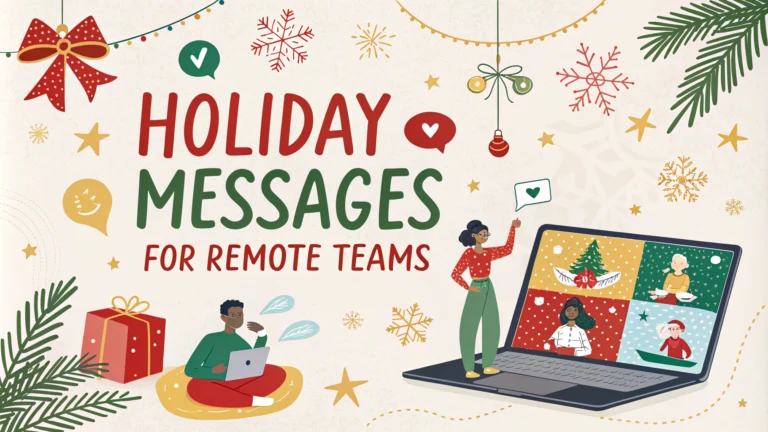Sending thoughtful holiday messages helps maintain team spirit and connection when working with remote colleagues.
Quick Message Templates for Different Occasions
End-of-Year Messages
- “Thank you for making this year successful despite the distance – your dedication shines through every video call!”
- “As we wrap up [YEAR], I’m grateful to work with such an amazing remote team.”
- “Distance hasn’t stopped us from achieving great things together this year.”
Winter Holiday Messages
- “Wishing you warmth and joy this holiday season, wherever you’re celebrating!”
- “May your home office be merry and bright!”
- “Here’s to celebrating together, even when we’re apart.”
Tips for Writing Effective Remote Holiday Messages
Personalize each message by referencing specific team achievements or memorable virtual moments.
Consider different time zones when scheduling holiday message deliveries.
Use your company’s internal communication platform to ensure messages reach everyone.
Creative Ways to Share Holiday Spirit Remotely
- Virtual Holiday Cards: Use tools like Canva or Paperless Post
- Digital Gift Cards: Send through platforms like Amazon or local businesses in team members’ locations
- Video Messages: Record personal greetings using Loom or similar platforms
Cultural Considerations
Research and acknowledge different holidays celebrated by your international team members.
Use inclusive language that respects various cultural traditions.
| Holiday | Appropriate Greeting |
|---|---|
| General Winter | “Season’s Greetings” |
| New Year | “Happy New Year” |
| Non-specific | “Happy Holidays” |
Timing Your Messages
Schedule group messages during overlapping business hours across time zones.
Send individual messages during the recipient’s working hours.
Additional Tips for Remote Holiday Communication
- Create a shared digital holiday card where team members can add messages
- Organize virtual holiday celebrations through platforms like Zoom or Microsoft Teams
- Set up holiday-themed virtual backgrounds for team meetings
- Share local holiday traditions through photos or short videos
Remember to maintain professional boundaries while keeping messages warm and personal.
Save copies of well-received holiday messages as templates for future use.
Best Practices for Remote Holiday Communication
- Keep messages concise but meaningful
- Balance professional tone with personal warmth
- Include specific mentions of team accomplishments
- Follow up on holiday messages with brief check-ins
Remote Team Building During Holidays
Virtual Activities
- Online Secret Santa exchanges
- Virtual holiday cooking classes
- Remote team holiday trivia games
- Digital holiday photo contests
Collaborative Projects
- Create a team holiday playlist
- Develop a digital holiday cookbook
- Design a virtual holiday scrapbook
Measuring Holiday Communication Impact
Track engagement through response rates and team feedback to improve future holiday communications.
Monitor team morale and connection levels during and after holiday periods.
Conclusion
Effective holiday communication in remote teams requires thoughtful planning, cultural awareness, and creative approaches to sharing celebration moments. By implementing these strategies and maintaining consistent communication practices, teams can foster stronger connections despite physical distance.
- Keep messages authentic and personal
- Respect cultural differences
- Use technology creatively
- Focus on building lasting connections
FAQs
- What are appropriate holiday messages for remote teams during end-of-year celebrations?
Professional yet warm wishes that acknowledge the team’s hard work, express gratitude, and recognize cultural diversity. Examples include “Thank you for your dedication this year” or “Wishing you and your loved ones a peaceful holiday season.” - How can managers ensure holiday messages reach remote team members in different time zones?
Schedule messages considering various time zones, use asynchronous communication tools, and send greetings 24-48 hours before major holidays to ensure everyone receives them during their local business hours. - What are inclusive ways to acknowledge different holidays celebrated by remote team members?
Use general terms like “holiday season” or “end-of-year celebrations,” acknowledge multiple holidays (Christmas, Hanukkah, Kwanzaa, etc.), and invite team members to share their traditions if they wish. - Should holiday messages be sent via email, team chat, or video?
Use multiple channels for maximum impact – formal emails for official wishes, team chat for casual greetings, and video messages for personal touch. Consider recording a brief video message for a more personal connection. - How can virtual holiday celebrations be incorporated into messages for remote teams?
Include virtual event details, digital gift card information, or links to online team activities in holiday messages. Consider adding virtual celebration schedule and participation instructions. - What are appropriate professional holiday gift mentions in remote team messages?
Reference company-wide digital gifts, gift cards, or care packages being sent. Ensure message includes clear information about any holiday bonuses or gifts without creating inequity. - How can holiday messages maintain team connection in a remote environment?
Include team achievements, shared memories from the year, and specific appreciation for remote collaboration. Reference team-building moments and virtual successes throughout the year. - What’s the best timing for sending holiday messages to remote teams?
Send primary holiday messages 1-2 weeks before major holidays, with follow-up greetings closer to specific dates. Consider business closure dates and vacation schedules. - How should managers handle religious holiday greetings in a diverse remote team?
Keep messages secular and inclusive, focus on universal themes like peace and gratitude, and respect individual beliefs. Avoid assumptions about holiday celebrations. - What elements should be included in end-of-year holiday messages for remote teams?
Include appreciation for specific contributions, acknowledgment of challenges overcome, optimism for the future, and clear information about holiday operational schedules or closures.







